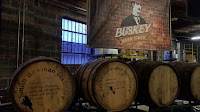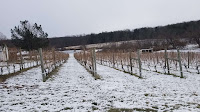Wairau Valley has a warm, dry climate that is moderated during the growing season by sea breezes from Cloudy Bay. Hot sunshine during the day and cold ocean winds at night extend the ripening period in the grapes, leading to a balance of fruit complexity and acidity. This diurnal temperature variation is essential to the terroir in the Wairau Valley – without it, much of the classic punchiness of the wines made here would be lost. (wine-searcher.com)
Sauvignon Blanc accounts for over three-quarters of New Zealand's wine exports which focus on the fresher styles -- fermenting and storing in stainless steel to retain the grape's naturally high acidity. Wine-searcher.com has an interesting note that "the original plant material for much of the Sauvignon Blanc planted in Marlborough in the 1980s, 90s and today traces its way via Australia and the University of California, Davis. This latter institution sourced their rootstock from Wente Vineyards (the cuttings were taken by the legendary grape breeder, Dr. Harold Olmo, in 1958) who got theirs from a vineyard established in the late 19th Centruy with cuttings from the Sauternes estate, Château d'Yquem".
Wairau River Wines is a Wairau Valley producer located on the eastern side of the valley within the most prolific wine-growing area where the Wairau River meets the Pacific Ocean. The winery was founded in 1978 when Phil and Chris Rose planted their first vineyard. After a decade of contract growing, they established the Wairau River Wines brand in 1991 and currently release ten varietal wines including New Zealand's signature Sauvignon Blanc. Their sons Hamish (viticulturist), Sam (winemaker), Pip (hospitality), and Rose (chef) have assumed the major responsibilities showing that the Rose family implemented a succession plan that is sadly missing for so many family operations.I received their Wairau River Estate Sauvignon Blanc 2021 ($20.99) in conjunction with a #BackToNature campaign highlighting the confluence of quality wine and heading outdoors. With the industry-wide adoption of screwcaps, New Zealand wines are at the forefront of enjoying these wines outdoors. The Wairau River Sauvignon Blanc is an excellent choice for both indoor and outdoor consumption. The wine starts with tangly grapefruit on the nose that leads to a textured body of stone fruits and finishes with a long, dry, and refreshingly acidic tail. For a family that likes to hike and fish the wine pairs nicely with freshly caught trout cooked using the Wairau River Solos Stove. Cheers.













































